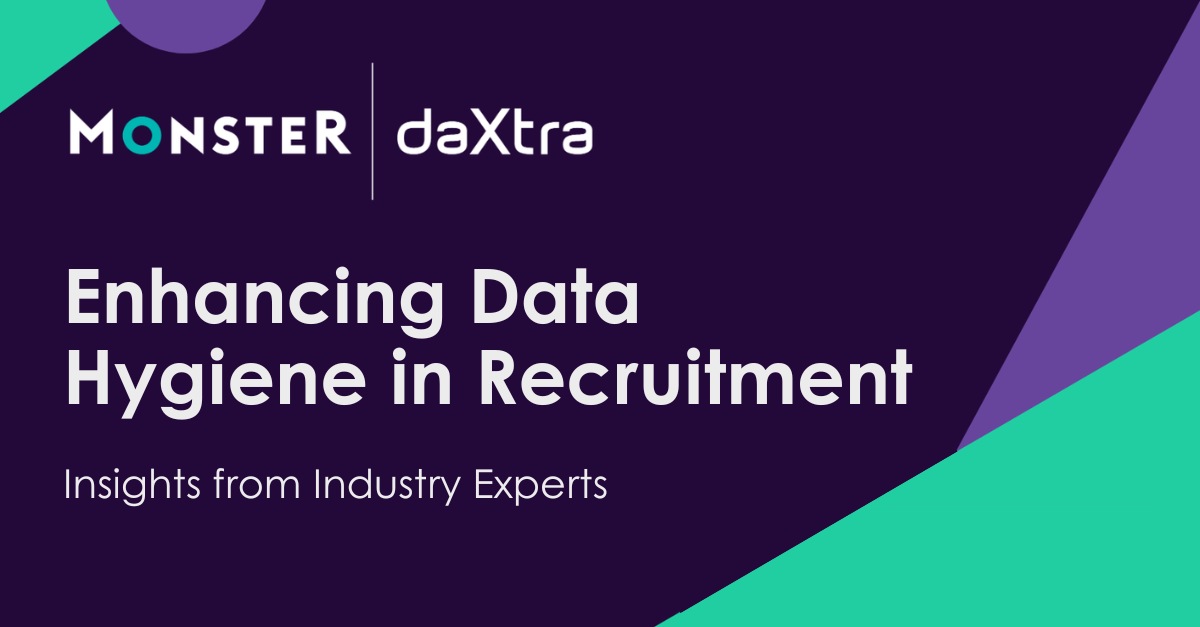Data is the foundation of any effective recruiting strategy. It’s also the cornerstone of any solid, well-functioning tech stack—without good data, your automation, AI tools and workflows won’t work like they should.
That’s why, in our latest partner webinar, we partnered with Monster to sit down with industry experts Alex Barron (Director of Recruiting and Sales Operations at Innova Solutions), Chris Wirt (VP of Sales - Americas at Daxtra) and Danny Ashraf (Director of Sales at Monster). Together, they broke down the intricacies of data hygiene, why it has a critical role in recruitment operations and what steps companies can take to clean up their data.
The Importance of Data Hygiene in Recruitment
What is data hygiene?
Data hygiene refers to the process of ensuring that data is clean, accurate, and up-to-date. In the context of recruitment, this means maintaining precise candidate information, job details, and other relevant data within your Applicant Tracking System (ATS) and other recruitment technologies.
Why does data hygiene matter?
Accurate data is important for several reasons:
- It allows recruiters to make informed decisions based on reliable information instead of outdated or incorrect information.
- It powers your tech, which can affect several parts of recruiting operations, from sourcing to candidate engagement.
- It has long-reaching effects on your organization's reputation among candidates. Outreach built on clean data can build trust, while inaccurate data can fuel ineffective outreach that may damage your reputation or provide a negative candidate experience (for example, emailing the same person twice due to duplicate profiles).
Simply put, data is at the core of recruiting operations - so it has to be as accurate as possible.
Key Challenges in Maintaining Data Hygiene
Demographic Trends and Job Tenure
According to data from the USPS, 133.4 million address changes were filed between 2020 and 2023.
This tracks for a post-pandemic world: fewer millennials and Gen Z workers are buying homes, and many of them are working remotely, which gives them greater flexibility in where they choose to live and work.
This flexibility means that candidate data changes frequently.
“Imagine if a third of the addresses or job titles or recent job history in your ATS are out of date and the impact that could have,” said Danny Ashraf.
Thus, recruiters need to be making frequent updates to maintain up-to-date candidate information in their databases.
Prevalence of Duplicates
Because data changes so quickly, duplicate data entries are a common issue that can lead to confusion and dissatisfaction among both recruiters and candidates.
“Even companies that have exhaustive processes and procedures in place to ensure duplicates don’t happen to have duplicates,” Danny Ashraf said. “I don’t know a single recruiter that has never found a rock star candidate and tried to get them into their system and not added, say, an extra vowel to their first name to try to get the candidate in the system under their ownership.”
This kind of duplication can happen in any industry. Danny Ashraf added that in one study, a company “analyzed over 10 billion Salesforce records last year found that almost half of them are duplicates.”
Alex Barron also said that that kind of duplication can wreak havoc on your system.
“We were doing a big contract renegotiation with a vendor,” she said. “We were consolidating multiple contracts into one big one, at the finish line and ready to sign. A day later, our C-suite got a sales email asking for a meeting to talk about new opportunities—and were pretty put off by getting a sales email after they had just been asked for approval on a big contract.”
In a world where trust is paramount, Chris Wirt said, bad data can have a big brand impact.
“If you have an old profile or two conflicting profiles, your automation and messaging to engage can come across as spammy and wreak havoc on the trust someone has in your brand,” he said.
This means that data errors don’t just impact the day-to-day experience of recruiters working in the system, but can have far-reaching business impacts, too.
Financial Impact of Bad Data
In 2023, Gartner found that organizations lose, on average, $12.9 million in revenue due to bad data.
“You can have revenue loss directly from customers with something like what Alex experienced,” Danny Ashraf continued. “And then there’s a further downstream impact like Chris touched on from a trust perspective, where something like your firm’s NPS score can decrease due to mixed messaging you’re putting into the market.”
Chris Wirt also notes that companies should consider both the financial impact of existing data and the financial impact of data that does not make it into the database.
“I started giving out a little homework assignment to prospective Daxtra customers, and asked them to review their job board views and applications received in the last 12 months,” he said. “Then, they compared it to their ATS over that same time period. We found that over the course of maybe 15 or 20 different customer examples, only about 15% of the job board views and applications they paid for were actually making it into the ATS.”
If you don't fully capture the data you’re paying for, your ROI can be severely limited in the long run.
Day-to-Day Challenges for Recruiters
In addition to the broader impacts, poor data hygiene can create daily challenges for recruiters. They could be dealing with poor source attribution, where inaccurate data entry means that sources aren’t tracked or evaluated effectively.
Or, they could lose valuable time connecting with candidates, instead having to spend it on manual data entry. The process of manually entering data is time-consuming and can be more prone to errors, especially when a do-over is required to correct incomplete or incorrect data
Chris Wirt notes the importance of day-to-day workflows, and how they can impact quality of life for recruiters.
“The general sense that I get from recruiters I’ve worked with is that when you think about getting into recruiting, you think about connecting with people, building relationships and helping people further their careers,” he said. “What a lot of people don’t realize is that recruiters are wearing so many different hats. Over the years, I’ve found the amount of time they’ve spent communicating and building relationships has declined. Now, they’re creating search strings and saving them in a Word doc or Excel file, or trying to prompt ChatGPT to create better content or search strings. They’re bouncing around from their ATS to 10 or 15 different tabs, all while trying to engage with candidates in an increasingly competitive environment.”
With so many tasks to juggle, it becomes more challenging to, say, make sure a job board source is updated correctly, or that you’ve correctly tagged a candidate's skills or experience in an ATS.
As a result, data entry is often overlooked because recruiters simply don’t have enough time to fill out any information beyond the basic requirements to add someone to the system—resulting in incomplete or inaccurate candidate information.
Best Practices for Enhancing Data Hygiene
Regular Data Audits
Conducting regular data audits is essential to identify and correct inaccuracies. This could involve:
- Regularly reviewing data entries to ensure they are accurate and up-to-date.
- Using technology tools to identify and eliminate duplicate entries.
- Creating simple, intuitive guardrails and processes that help ensure candidate information is regularly updated to reflect changes.
Training and Awareness
Ensuring that your team is aware of the impact of inaccurate data and the ways that clean data can streamline your work, as well as best practices for data hygiene, can significantly improve data quality.
For example, standardized data entry procedures to minimize errors (or make them easier to identify), meetings to provide training or education can help spread awareness, and incentives to regularly update candidate information can help ensure your organization is aligned on data hygiene.
Updating Data through Personalized Engagement
Personalized engagement is a valuable tool.
“Engagement isn’t a one-and-done tool,” Danny Ashraf said. “It has to live and breathe and be a part of your company’s culture, operating procedures and workflows. It’s important that you’re always updating your data—and that starts with texting and emailing. But, you have to do more than just solicit candidates for information. You need to be thinking about how you add value to the lives of candidates and customers through content, so that they want to engage with you.”
Keeping up communication with personalized engagement—whether it’s a text or email to share relevant content, or a phone call to check in on their career journey—can have a lasting effect, and help candidates keep recruiters in mind for when they’re ready to make their next move.
Leveraging Technology
With recruiters wearing so many hats, it’s more important than ever to capture all relevant data. It’s also easier than ever to see the impact of incomplete data on ROI. But, leveraging advanced technology solutions can reduce recruiters' workloads, help streamline data management processes, and ensure data accuracy.
Chris Wirt noted:
“It’s common for us to talk to someone who did a data clean-up project last year and plans to do another clean-up project the following year, but in-between didn’t do anything to solve for the bad data that made it into the system in the first place. One of the biggest impacts tech can have is putting guardrails on data management strategies to automate those manual processes and take the decision out of a recruiter’s hands. That way, they don’t have to think about “Do I load this candidate into the database or not?” — you can set up automated processes so the candidate info is already funneled in, without duplicates.”
Driving Results through Data
Data hygiene plays a critical role in improving decision-making, enhancing client satisfaction, and boosting financial performance. By leveraging technology, conducting regular data audits, and providing training and awareness, recruitment firms can significantly improve their data hygiene practices and achieve better outcomes.
By implementing the actionable advice and best practices discussed in this article, recruiters can enhance their data hygiene and drive better results in their operations.
Want to hear more from our panelists? Check out the full webinar recording, or get in touch with Alex, Chris or Danny on LinkedIn.



